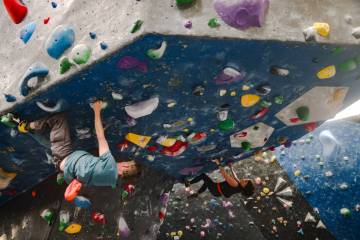‘After Earth’ joins exclusive ultra-HD movie club
LOS ANGELES -- Sony Corp. is taking a deeper dive into ultrahigh-definition video as it comes out Friday with “After Earth,” the first of Sony’s three movies this year both shot and presented in the emerging 4K digital format. At a screening for journalists, I got a close-up look at even the pores on Will Smith’s face as details were rendered with greater clarity on the big screen.
Sony and other consumer electronics makers are betting that 4K images will become the new standard, prompting consumers to buy fancier TVs just as they did when high definition, or HD, rolled out over the past decade. It could also entice more people to buy movie tickets to see for themselves what the super-clear format is like.
But the more detailed images present a host of problems. They use four times the number of pixels as the current HD standard, which results in larger data files. Budget-strapped digital effects companies are having trouble handling all that data. The cost and time to deal with the extra visual information means the majority of the special effects shots in “After Earth” - comprising about a third of all the shots in the movie - were actually worked on in lower-resolution HD.
At the screening I attended, I could see details I’ve never noticed before - the actors’ tiny skin imperfections, or Smith’s salt-and-pepper whiskers. In a distant shot of Smith’s son Jaden running down a riverbed, I was struck by how many small rocks were defined clearly from such a distance. Yet other shots that included computer-generated cityscapes or otherworldly creatures looked less sharp. I was sitting in the seventh row - close enough to tell the difference. If you sit at the back of a theater, you might not be able to tell the difference between 4K and HD.
Sony has 15,000 4K projectors installed in theaters worldwide, with more than 11,000 in the U.S. Other manufacturers such as Barco, Christie and NEC also make 4K projectors.
So far, major theater chains Regal and AMC are not charging extra for 4K screenings. AMC says nearly all of its 344 theaters have at least one 4K projector. Regal says more than 300 of its 579 theaters have a 4K projector. You’ll have to check with your local theater to see if the movie will be projected in 4K.
The push toward higher resolution follows the industry’s emphasis on HD in recent years. Many TV sets tout the “1080p” resolution standard, so named because its images are 1,080 pixels high and 1,920 pixels wide. A slightly wider version with 2,048 pixels across is known as 2K. But 4K is 4,096 pixels wide and 2,160 pixels high. That gives 4K images 8.8 million pixels compared with roughly 2 million for high definition.
Higher-definition movies are a key component in Sony’s strategy to maximize the benefits of both owning the Sony Pictures movie studio and making electronic gadgets.
Sony Electronics makes 4K motion picture cameras - such as the F65 used to shoot “After Earth” - as well as 4K movie theater projectors, 4K TVs, home media servers that play 4K movies and other technologies needed to get ultra-HD video from one end to the other. The camera-making division has even had talks with Sony Music Entertainment about shooting concerts in 4K.
“It touches an awful lot of the ecosystem,” says Rob Willox, director of large sensor technology for Sony Electronics.
So far, 56 movies have been converted to 4K, the majority distributed by Sony. Those include ones originally shot on film, including last year’s Oscar-nominated “Django Unchained.” Sony’s other end-to-end 4K releases planned for this year are “The Smurfs 2,” due out in July, and “No Good Deed,” set for release in October.
After Red Digital Cinema began selling a 4K camera, the Red One, in 2007, companies including Sony and Canon Inc. also began making them. Thousands of movies have been shot in 4K, but almost all of them have been shrunk down to HD format before being screened. One exception was Sony’s 2011 remake of “The Girl with the Dragon Tattoo,” which was shot in 4K with a Red camera and also shown in theaters that way. Having “After Earth” and two others on the release schedule this year marks another milestone for the format.
“There is a new movement now where movies are actually being shot at high resolution and finished at high resolution,” says Ted Schilowitz, a co-founder of Red. “We see huge advantages to deliver four times as many pixels on the screen as HD.”
The cinematographer of “After Earth,” Peter Suschitzky, says he picked Sony’s F65 digital camera after side-by-side comparisons of footage taken by other digital and film cameras. Although some people prefer film for its sometimes grainy, soft, romantic look, Suschitzky says those benefits are lost when shown in theaters with digital projectors, as many are today.
He says he likes the look of the movie and regrets that special effects scenes were mostly done at the lower standard.
“True 4K is amazingly detailed,” he says. “The movie is only half in true 4K. I’m sad about that. It still looks good.”
Sony executives say the increased pixel count has made its F65 camera more sensitive than either film or other digital cameras in low-light situations, enabling filmmakers to shoot with more natural lighting.
There were some low-light scenes in “After Earth,” such as when Jaden Smith’s character is in a cave, but I didn’t notice any particular clarity there. Where I did notice extra detail was in scenes that were slow and still, and where the actors’ faces were shot close up.
Chris Cookson, the president of Sony Pictures Technologies, keyed in on how the F65 camera catches subtleties.
“Look at how much more lifelike the eyes and faces are,” he says. “I personally think there’s more life in human beings when you see them in a way that doesn’t have that filtering effect when you’re looking at HD.”
The increased number of pixels involved in 4K movies creates extra work for special effects artists, especially on effects that require a human touch, such as the pixel-by-pixel cutouts of objects in each frame known as “rotoscoping.”
Working entirely in 4K means a movie could take up to 30 percent more time, as well more money on labor and better computers, says Jenny Fulle, chief executive of The Creative-Cartel, which handled the special effects in “After Earth.”
The extra cost and time is one of the reasons that the sci-fi flick starring Tom Cruise, “Oblivion,” was released in 2K in April. It would have cost an extra $1.5 million to finish the film in 4K, according to Sony Electronics’ business development manager, Keith Vidger.
Jeffrey Okun, chairman of the Visual Effects Society, a nonprofit organization of Hollywood special effects practitioners, says that making the change to all-4K effects will be difficult but necessary. He calls it “another leap in quality.”
“No industry has made more leaps in a shorter amount of time than the visual effects industry,” he says.
Ultimately, 4K may mean new TVs for consumers, too.
At the International CES gadget show in Las Vegas in January, several electronics manufacturers including Sony, Samsung Electronics Co. and LG Electronics Inc. showed off smaller sizes of 4K TVs whose screens spanned as little as 55 inches diagonally.
Sony’s 55-inch ultra-HD TV is selling at Best Buy for $5,000. Gerald Belson, a media industry consultant for accounting and consulting firm Deloitte, says the price is “already at the level of some of the early 1080p sets.” His firm predicts that within five years, 4K TV prices will drop below $1,000.
The 4K format is also an easier upgrade for most people than 3-D, which in most cases requires wearing special glasses that people find uncomfortable, says Sweta Dash, an analyst with research firm IHS iSuppli. The company predicts companies will ship nearly 1 million ultra-HD sets this year, growing to 7.1 million in 2015 and 20.8 million in 2017.
Even though there isn’t much 4K video content now - and 4K broadcasts are likely years away - Dash says the format will likely become popular as TV set prices come down and content grows. But she warned that studios, theaters and electronics makers need to explain exactly what people are watching.
Some movies - like “After Earth” - have portions rendered at a lower standard, and some TV sets touted as 4K have only about 1,000 pixels vertically, robbing consumers of half of the extra pixel definition they think they’re getting.
“If the content and the picture quality is not up to their expectations, it can impact this negatively,” she says. “The more you clarify, the better. The less confusion, the better the adoption of the new technology.”




























